There is a popular generalization about Italian cooking that assigns butter to the north, olive oil to the south, and lard to the middle regions of the country, but this doesn’t begin to do justice to its complexity. The generalization, I was told, had to do with an earlier time, before refrigeration, when it was more difficult to keep and work with butter in the southern regions. Differences in Italy’s regional cuisines might also be traced to geography or political differences since its geography includes alpine, maritime, and even desert regions and the country wasn’t unified politically until 1861. Whatever the reasons, this small country has an incredible diversity of culinary styles from German- influenced food in the Tirol to the food of Rome’s Jewish ghetto and the savory African influences of Sicily.  A quick visit isn’t likely to raise your awareness of those vast differences in Italian food cultures either. One might be disappointed if that visit is to Tuscany where every menu looks identical and the bread is bland because it’s made without salt. On the other hand, in Emilia-Romagna dishes up the staples of world-famous Italian products – prosciutto from Parma, parmesan cheese from Reggiano and balsamic vinegar from Modena. A culinary journey through Italy is varied and tasty. I thought I knew something about Italian food; after all I once owned and ran a small Italian bistro. But, it turns out I didn’t know anything about Roman cuisine until my current stay in Rome. I wasn’t aware, for instance, that lightly fried vegetables – squash blossoms, cauliflower, broccoli, and zucchini – are a common antipasto offering. In addition, I had no clue as to the influence of Rome’s Jewish ghetto on its cuisine. Since M and I arrived, fried artichokes with their delicate, crunchy texture and carmelized sweetness have become one of our favorite side dishes at dinner.
A quick visit isn’t likely to raise your awareness of those vast differences in Italian food cultures either. One might be disappointed if that visit is to Tuscany where every menu looks identical and the bread is bland because it’s made without salt. On the other hand, in Emilia-Romagna dishes up the staples of world-famous Italian products – prosciutto from Parma, parmesan cheese from Reggiano and balsamic vinegar from Modena. A culinary journey through Italy is varied and tasty. I thought I knew something about Italian food; after all I once owned and ran a small Italian bistro. But, it turns out I didn’t know anything about Roman cuisine until my current stay in Rome. I wasn’t aware, for instance, that lightly fried vegetables – squash blossoms, cauliflower, broccoli, and zucchini – are a common antipasto offering. In addition, I had no clue as to the influence of Rome’s Jewish ghetto on its cuisine. Since M and I arrived, fried artichokes with their delicate, crunchy texture and carmelized sweetness have become one of our favorite side dishes at dinner.
Before we left Seattle, at the urging of my daughter, we watched Anthony Bourdain’s No Reservations episode on eating in Rome. In the video he waxes on about cacio y pepe pasta, something I wasn’t familiar with in spite of the fact that for 8 years I made 10-15lbs of fresh pasta every day. When we arrived in Rome I had to have it. I couldn’t imagine what could be so seductive about a pasta dish whose only ingredients were pecorino cheese and black pepper. Now I understand. Cacio y pepe is deceptively simple, but when we started to look into its preparation we discovered there is an art to making it that includes warming the dish over the pot of pasta water, preserving some of the pasta water for later, adding the cheese to the warm bowl in small increments and stirring the water and cheese to obtain the right creamy texture. When it’s well prepared you would swear there is butter and heavy cream included but there is nothing but water, aged pecorino, and love in the mixture. 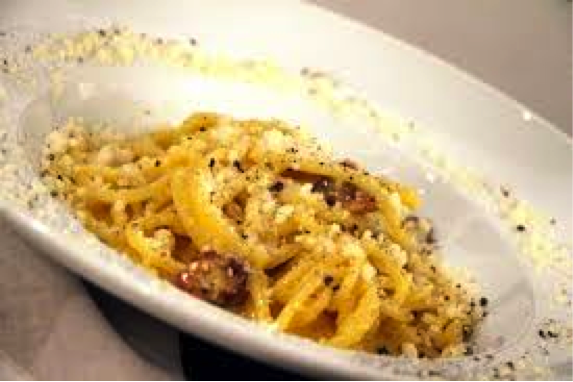 It’s amazing. I’ve made it my go-to dish in Rome and I’m looking for differences. So far, the only differences are in quality. I’ve had one bad, one incredible, and several very good. At Baccanale 59, a small restaurant in the Prati district, it was served in a bowl made of lacy toasted Reggiano. There are two favorite pasta choices for cacio y pepe; the traditional is spaghetti-like tonnarelli sometimes called alla chitarra (named for the guitar-like tool used to cut its square shape), and rigatoni, the large, ridged, hollow, pasta. Both of them hold the sauce well, but the tonnarelli seems to be the preferred choice.
It’s amazing. I’ve made it my go-to dish in Rome and I’m looking for differences. So far, the only differences are in quality. I’ve had one bad, one incredible, and several very good. At Baccanale 59, a small restaurant in the Prati district, it was served in a bowl made of lacy toasted Reggiano. There are two favorite pasta choices for cacio y pepe; the traditional is spaghetti-like tonnarelli sometimes called alla chitarra (named for the guitar-like tool used to cut its square shape), and rigatoni, the large, ridged, hollow, pasta. Both of them hold the sauce well, but the tonnarelli seems to be the preferred choice. 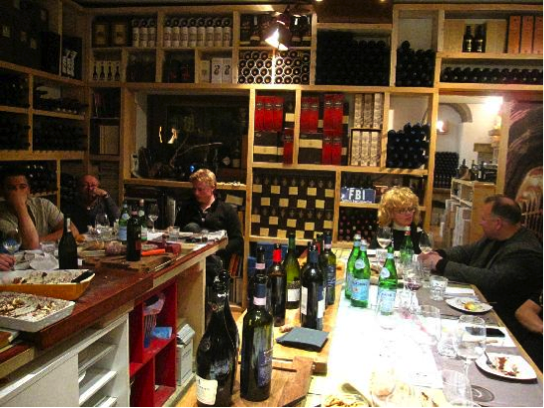 Tonight the search for the perfect cacio y pepe is taking us to a bakery/deli/bar/restaurant called Roscioli’s, near the old Jewish ghetto. It’s where Bourdain found the Holy Grail of Roman pasta. As I’m learning about cacio y pepe I’m also learning that Romans prefer white wine to red and that Aperitivo is like Happy Hour in the US. One evening we ordered two glasses of wine at our local bar/café, and when they brought the wine they also brought a dish of potato chips, a cup of peanuts, some olives, and a platter with six small pastry-like hors d’ouevres. It was a meal. It apparently started in Milan but Rome has perfected it. Since our discovery, we often eat our big meal in the middle of the day and enjoy Aperitivo as a small meal late in the evening when it cools down. It’s the closest thing to a free lunch in Rome. Rome is full of attractions and surprises, feasts for the eyes and the tongue. I love having the time to learn about it and to explore its special tastes and unique flavors. I hope you will too.
Tonight the search for the perfect cacio y pepe is taking us to a bakery/deli/bar/restaurant called Roscioli’s, near the old Jewish ghetto. It’s where Bourdain found the Holy Grail of Roman pasta. As I’m learning about cacio y pepe I’m also learning that Romans prefer white wine to red and that Aperitivo is like Happy Hour in the US. One evening we ordered two glasses of wine at our local bar/café, and when they brought the wine they also brought a dish of potato chips, a cup of peanuts, some olives, and a platter with six small pastry-like hors d’ouevres. It was a meal. It apparently started in Milan but Rome has perfected it. Since our discovery, we often eat our big meal in the middle of the day and enjoy Aperitivo as a small meal late in the evening when it cools down. It’s the closest thing to a free lunch in Rome. Rome is full of attractions and surprises, feasts for the eyes and the tongue. I love having the time to learn about it and to explore its special tastes and unique flavors. I hope you will too.
Buon Appetito
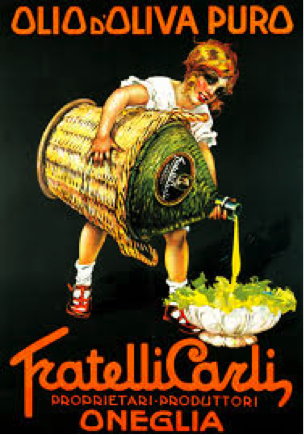
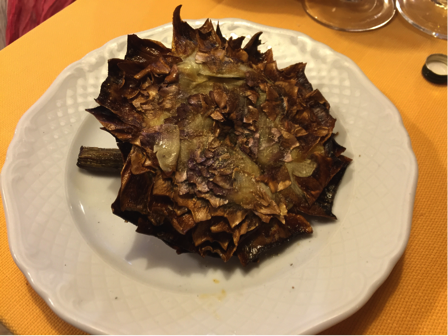































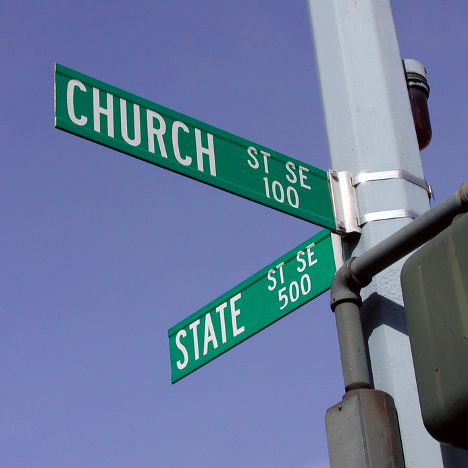
Love this. I have read about that pasta dish in the NYT. Must try. My daughter ate at Pizzeria Roscioli as often as possible, near the campo di Fiori on a tiny, twisting street. She also says ‘tell your friend to eat lots of Gelateria La Romana. Nothing compares.” Enjoy! Love following your meanderings. A.